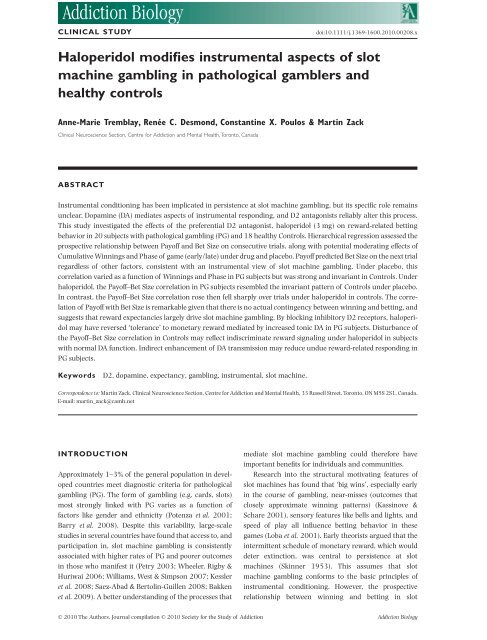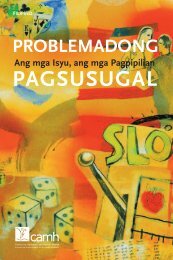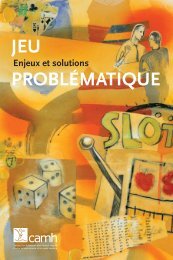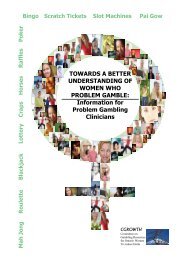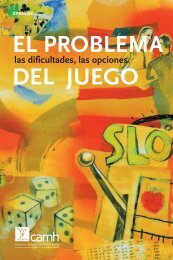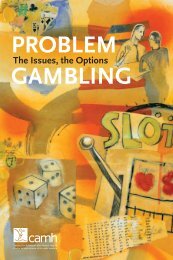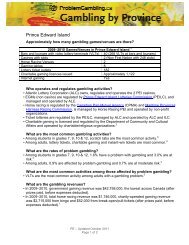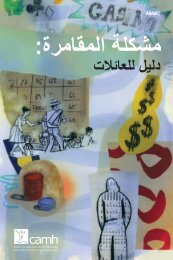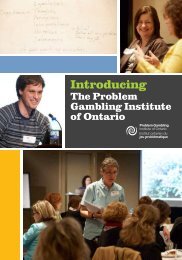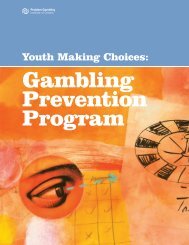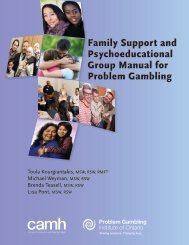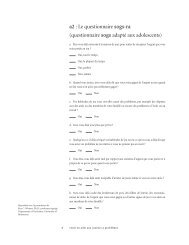Haloperidol and slot machine gambling - ProblemGambling.ca
Haloperidol and slot machine gambling - ProblemGambling.ca
Haloperidol and slot machine gambling - ProblemGambling.ca
Create successful ePaper yourself
Turn your PDF publications into a flip-book with our unique Google optimized e-Paper software.
1..18Addiction BiologyCLINICAL STUDYdoi:10.1111/j.1369-1600.2010.00208.x<strong>Haloperidol</strong> modifies instrumental aspects of <strong>slot</strong><strong>machine</strong> <strong>gambling</strong> in pathologi<strong>ca</strong>l gamblers <strong>and</strong>healthy controlsAnne-Marie Tremblay, Renée C. Desmond, Constantine X. Poulos & Martin ZackClini<strong>ca</strong>l Neuroscience Section, Centre for Addiction <strong>and</strong> Mental Health,Toronto, CanadaABSTRACT adb_208Instrumental conditioning has been impli<strong>ca</strong>ted in persistence at <strong>slot</strong> <strong>machine</strong> <strong>gambling</strong>, but its specific role remainsunclear. Dopamine (DA) mediates aspects of instrumental responding, <strong>and</strong> D2 antagonists reliably alter this process.This study investigated the effects of the preferential D2 antagonist, haloperidol (3 mg) on reward-related bettingbehavior in 20 subjects with pathologi<strong>ca</strong>l <strong>gambling</strong> (PG) <strong>and</strong> 18 healthy Controls. Hierarchi<strong>ca</strong>l regression assessed theprospective relationship between Payoff <strong>and</strong> Bet Size on consecutive trials, along with potential moderating effects ofCumulative Winnings <strong>and</strong> Phase of game (early/late) under drug <strong>and</strong> placebo. Payoff predicted Bet Size on the next trialregardless of other factors, consistent with an instrumental view of <strong>slot</strong> <strong>machine</strong> <strong>gambling</strong>. Under placebo, thiscorrelation varied as a function of Winnings <strong>and</strong> Phase in PG subjects but was strong <strong>and</strong> invariant in Controls. Underhaloperidol, the Payoff–Bet Size correlation in PG subjects resembled the invariant pattern of Controls under placebo.In contrast, the Payoff–Bet Size correlation rose then fell sharply over trials under haloperidol in controls. The correlationof Payoff with Bet Size is remarkable given that there is no actual contingency between winning <strong>and</strong> betting, <strong>and</strong>suggests that reward expectancies largely drive <strong>slot</strong> <strong>machine</strong> <strong>gambling</strong>. By blocking inhibitory D2 receptors, haloperidolmay have reversed ‘tolerance’ to monetary reward mediated by increased tonic DA in PG subjects. Disturbance ofthe Payoff–Bet Size correlation in Controls may reflect indiscriminate reward signaling under haloperidol in subjectswith normal DA function. Indirect enhancement of DA transmission may reduce undue reward-related responding inPG subjects.KeywordsD2, dopamine, expectancy, <strong>gambling</strong>, instrumental, <strong>slot</strong> <strong>machine</strong>.Correspondence to: Martin Zack, Clini<strong>ca</strong>l Neuroscience Section, Centre for Addiction <strong>and</strong> Mental Health, 33 Russell Street, Toronto, ON M5S 2S1, Canada.E-mail: martin_zack@<strong>ca</strong>mh.netINTRODUCTIONApproximately 1–3% of the general population in developedcountries meet diagnostic criteria for pathologi<strong>ca</strong>l<strong>gambling</strong> (PG). The form of <strong>gambling</strong> (e.g. <strong>ca</strong>rds, <strong>slot</strong>s)most strongly linked with PG varies as a function offactors like gender <strong>and</strong> ethnicity (Potenza et al. 2001;Barry et al. 2008). Despite this variability, large-s<strong>ca</strong>lestudies in several countries have found that access to, <strong>and</strong>participation in, <strong>slot</strong> <strong>machine</strong> <strong>gambling</strong> is consistentlyassociated with higher rates of PG <strong>and</strong> poorer outcomesin those who manifest it (Petry 2003; Wheeler, Rigby &Huriwai 2006; Williams, West & Simpson 2007; Kessleret al. 2008; Saez-Abad & Bertolin-Guillen 2008; Bakkenet al. 2009). A better underst<strong>and</strong>ing of the processes thatmediate <strong>slot</strong> <strong>machine</strong> <strong>gambling</strong> could therefore haveimportant benefits for individuals <strong>and</strong> communities.Research into the structural motivating features of<strong>slot</strong> <strong>machine</strong>s has found that ‘big wins’, especially earlyin the course of <strong>gambling</strong>, near-misses (outcomes thatclosely approximate winning patterns) (Kassinove &Schare 2001), sensory features like bells <strong>and</strong> lights, <strong>and</strong>speed of play all influence betting behavior in thesegames (Loba et al. 2001). Early theorists argued that theintermittent schedule of monetary reward, which woulddeter extinction, was central to persistence at <strong>slot</strong><strong>machine</strong>s (Skinner 1953). This assumes that <strong>slot</strong><strong>machine</strong> <strong>gambling</strong> conforms to the basic principles ofinstrumental conditioning. However, the prospectiverelationship between winning <strong>and</strong> betting in <strong>slot</strong>© 2010 The Authors. Journal compilation © 2010 Society for the Study of Addiction Addiction Biology
2 Anne-Marie Tremblay et al.<strong>machine</strong>s remains unclear. Evidence for such a relationshipwould support a role for instrumental conditioningin <strong>slot</strong> <strong>machine</strong> <strong>gambling</strong> <strong>and</strong> suggest that insights fromthe extensive literature on instrumental conditioningcould be applied to reduce the harmful effects of thisactivity. The first goal of this study was to investigate therole of instrumental conditioning in <strong>slot</strong> <strong>machine</strong> <strong>gambling</strong>by directly assessing the relationship between payoff<strong>and</strong> bet size on consecutive trials over the course of thegame.Evidence that instrumental conditioning <strong>ca</strong>n explain<strong>slot</strong> <strong>machine</strong> betting patterns would also suggest whichneurochemi<strong>ca</strong>l processes mediate this behavior. In particular,it would suggest a key role for dopamine (DA),which, despite controversy over its specific roles in acquisitionversus expression of instrumental responses, iswidely accepted as a key determinant of positive reinforcement(Fields et al. 2007; Dalley & Everitt 2009). Abetter underst<strong>and</strong>ing of how DA affects the impact ofwinning on betting is also important given the criti<strong>ca</strong>lrole of DA in addiction (Robbins & Everitt 1999; Robinson& Berridge 2000; Volkow et al. 2007), to which PG hasbeen likened (Grant, Brewer & Potenza 2006), as well asthe apparent association between PG <strong>and</strong> Parkinson’sdisease (Voon, Potenza & Thomsen 2007a). To our knowledgeno research has directly investigated the role of DAon instrumental aspects of <strong>slot</strong> <strong>machine</strong> <strong>gambling</strong> in PGsubjects <strong>and</strong> non-PG controls. A second goal of this studywas to address this important gap in the literature.Imaging studies on neural responses to monetaryreward <strong>ca</strong>n provide a context for this investigation. In adecision-making task for varied amounts of monetaryreward, co<strong>ca</strong>ine abusers exhibit overall reduced regionalbrain reactivity to variations in the different monetaryvalue conditions (Goldstein et al. 2007). In a decision taskwith monetary reward <strong>and</strong> loss, alcohol abusers showreduced activation of ventral striatum during anticipationof monetary gain relative to controls (Wrase et al.2007). In a decision task with risky <strong>and</strong> safe monetaryrewards, a mixed sample of substance abusers displayreduced posterior mesofrontal cortex activation inresponse to risky rewards in particular (Bjork et al.2008). These findings echo previous functional magneticresonance imaging (fMRI) results for PG subjects: using a<strong>gambling</strong>-like guessing game, Reuter et al. (2005) foundthat PG subjects displayed signifi<strong>ca</strong>ntly less activation inthe medial prefrontal cortex <strong>and</strong> ventral striatum duringanticipation <strong>and</strong> receipt of monetary reward comparedwith healthy controls. In PG subjects, greater symptomseverity was associated with greater deficits in activationin both brain regions. Reuter et al. proposed that deficitsin striatal response could reflect decreased reward sensitivity(Volkow et al. 2002). If striatal activation accuratelyindexes the reinforcing value of monetary reward,Reuter et al.’s findings suggest that a given monetarypayoff should have less ability to promote betting behavioron a <strong>slot</strong> <strong>machine</strong> in PG subjects than in controls.The regional patterns of activation seen in fMRIstudies strongly suggest that they are measuring theactivity of DA neurons. Empiri<strong>ca</strong>l support for this wasprovided by Schott et al. (2008), who measured neuralactivation in healthy subjects during a <strong>gambling</strong> taskwith probabilistic monetary rewards <strong>and</strong> losses whileconcurrently assessing DA release in terms of displacementof the DA D2/D3 receptor lig<strong>and</strong> raclopride. Theyreported that ‘Across the cohort, a positive correlationemerged between neural activity of the substantia nigra/ventral tegmental area (SN/VTA), the main origin ofdopaminergic neurotransmission, during reward anticipation<strong>and</strong> reward-related [(11)C] raclopride displacementas an index of DA release in the ventral striatum,major target of SN/VTA dopamine neurons’ (p. 14 311).Thus, <strong>gambling</strong>-induced striatal activation does appearto index DA release in healthy subjects.Recently, Steeves et al. (2009) conducted a similarinvestigation in Parkinson’s patients with <strong>and</strong> withoutPG. They found that patients with PG demonstratedgreater decreases in raclopride binding in the ventralstriatum during <strong>gambling</strong> (13.9%) than controls did(8.1%), indi<strong>ca</strong>ting greater <strong>gambling</strong>-induced DA releasein the co-morbid group. Baseline striatal binding levelswere also lower in the co-morbid group. Thus, in contrastto PG subjects without Parkinson’s disease (Reuter et al.2005), PG subjects with Parkinson’s appear to exhibitmore rather than less striatal response to <strong>gambling</strong> thanmatched controls without PG. Although there is nodefinitive explanation for this discrepancy research onthe role of D2 receptors in reward-related learning inhealthy subjects may provide a clue.Parkinson’s disease involves profound alterations inDA function. Studies with healthy subjects suggest thatD2 antagonists <strong>ca</strong>n mimic some of the cognitive deficitsseen in Parkinson’s disease (Mehta et al. 1999). Researchon reward-related approach <strong>and</strong> avoidance learning inhealthy subjects treated with the preferential D2 agonist<strong>ca</strong>bergoline (1.25 mg), the preferential D2 antagonisthaloperidol (2 mg), or placebo (Frank & O’Reilly 2006)found ‘that <strong>ca</strong>bergoline impaired, while haloperidolenhanced, Go learning from positive reinforcement’ (p.497). The investigators also observed that ‘the oppositeeffects of <strong>ca</strong>bergoline <strong>and</strong> haloperidol on Go/No-Go learningdirectly repli<strong>ca</strong>te our prior results in Parkinson’spatients’ (p. 497). Together, these findings indi<strong>ca</strong>te that atmodest doses, D2 receptor antagonists <strong>ca</strong>n approximatethe cognitive <strong>and</strong> incentive-motivational profile of Parkinson’sdisease. Frank <strong>and</strong> O’Reilly noted that modestdoses of D2 antagonists act predominantly at presynapticreceptors, reducing these receptors’ inhibitory© 2010 The Authors. Journal compilation © 2010 Society for the Study of Addiction Addiction Biology
<strong>Haloperidol</strong> modifies instrumental aspects of <strong>slot</strong> <strong>machine</strong> <strong>gambling</strong> 3effects. As a result, DA release from rewarding stimulishould be enhanced. To the extent that this ‘disinhibitory’effect models the situation in Parkinson’s disease it mayexplain the relatively greater DA response to <strong>gambling</strong>seen in the Parkinson’s patients with PG (Steeves et al.2009). The lower baseline D2 levels (i.e. decreased inhibitorysignal) in the Parkinson’s patients with PG versusthose without PG are consistent with this possibility.The pattern of effects described above suggests that amodest dose of haloperidol in non-Parkinsonian PG subjectsmay approximate the effects seen in PG subjects withParkinson’s. That is, haloperidol may increase <strong>gambling</strong>inducedDA release in otherwise healthy PG subjects.Frank <strong>and</strong> O’Reilly’s results suggest that this effect mayalso be observed in non-PG controls. In motivationalterms, they suggest that a modest dose of haloperidolshould increase the ability of monetary reward to elicit abetting response. A test of the effects of haloperidol onreward-related betting behavior in a <strong>slot</strong> <strong>machine</strong> gamewould not only provide an opportunity to see if the patternconforms to instrumental learning principles; it wouldalso reveal whether the expected pattern of effects of D2blockade seen in experimental models of reinforcement<strong>and</strong> <strong>gambling</strong> emerge on an actual <strong>gambling</strong> device.Initial evidence provides indirect support for thesepossibilities. In a recent study, haloperidol (3 mg) wasfound to increase the subjective reinforcing effects of a15-minute episode of <strong>gambling</strong> on a commercial <strong>slot</strong><strong>machine</strong> in otherwise healthy PG subjects (n = 20), asevidenced by increased ratings of Enjoyment, Excitement<strong>and</strong> Involvement in the game <strong>and</strong> increased post-gameDesire to Gamble compared with placebo (Zack & Poulos2007). PG subjects also exhibited an enhanced cognitivepriming effect under the drug, as measured by greaterpost-game verbal fluency to Gambling words (e.g. wager)versus Neutral words (e.g. window) on a rapid readingtask. Addiction-related words have been found to activatethe mesocortico-limbic DA system in co<strong>ca</strong>ine addicts(Goldstein et al. 2009), supporting the possibility thatincreased DA release under haloperidol mediated theenhanced cognitive priming of Gambling words in PGsubjects. In contrast to the findings for PG subjects,healthy non-PG controls (n = 18) exhibited no change insubjective reinforcing or priming effects of the <strong>slot</strong><strong>machine</strong> game under haloperidol versus placebo (Zack &Poulos 2007). However, both PG subjects <strong>and</strong> Controlsexhibited a signifi<strong>ca</strong>nt <strong>and</strong> comparable post-gameincrease in systolic blood pressure relative to placebo,confirming that the drug was physiologi<strong>ca</strong>lly active inControls. Increased systolic blood pressure has beenfound to selectively coincide with increases in striatal DArelease in healthy subjects who received varying doses ofthe DA reuptake inhibitor methylphenidate (Volkow et al.2003). These findings are consistent with the possibilitythat haloperidol increased <strong>gambling</strong>-induced DA releasein PG subjects <strong>and</strong> Controls. However, group differencesin subjective <strong>and</strong> cognitive effects of haloperidol suggestthat increased DA release led to increased positive reinforcingeffects of the <strong>slot</strong> <strong>machine</strong> in PG subjects but notin Controls.Comparison of group mean betting scores on the <strong>slot</strong><strong>machine</strong> revealed no group by drug interactions. Eachgroup displayed equivalent mean bet size per trial <strong>and</strong>mean number of trials played under haloperidol versusplacebo. A group difference emerged for trials played,with PG subjects playing more trials (i.e. faster rate ofplay) than Controls under both drug <strong>and</strong> placebo. Therewere no differences in mean winnings received as a functionof drug condition or group. Thus, aggregate scoresdid not indi<strong>ca</strong>te a change in positive reinforcement underthe drug as operationally defined by an increase inaverage bet size or number of trials played.In the course of a <strong>slot</strong> <strong>machine</strong> game, as in all <strong>gambling</strong>activities, the occurrence <strong>and</strong> magnitude of monetarypayoffs varies. On some trials, the player mayreceive a large payoff; on others no payoff at all. Overall,these variations should average out across multiple subjects<strong>and</strong> sessions. Positive reinforcement involves anincrease in the probability of a response as a result of arewarding outcome. In a <strong>slot</strong> <strong>machine</strong> game, positivereinforcement <strong>ca</strong>n be indexed by an increase in the abilityof a given reward to elicit a betting response. The prospectivecorrelation between the size of a payoff on a giventrial (number of credits) <strong>and</strong> the size of the wager on thesubsequent trial (number of credits) gauges this effect<strong>and</strong> provides a complementary index of reinforcing effi<strong>ca</strong>cyin terms of the graded effects of varying rewards onthe strength of the criterion response (betting). The studycited above, in which co<strong>ca</strong>ine abusers displayed a bluntingin the differential neural response to varying amountsof monetary reward (Goldstein et al. 2007), suggests thata loss of reward-response <strong>ca</strong>libration may be an importantfeature of the addicted state. If PG subjects resembleco<strong>ca</strong>ine abusers cf. (Pallanti et al. 2006; Potenza 2008),they should exhibit a similar deficit in <strong>ca</strong>libration (i.e.weaker payoff–bet size correlation) compared with Controlsunder placebo. If an increase in reward-related DArelease rectifies this deficit, PG subjects should show asignifi<strong>ca</strong>nt increase in the strength of the payoff–bet sizecorrelation under haloperidol.The effects of haloperidol on reward-related bettingbehavior in healthy Controls may be predicted fromresearch on the effects of haloperidol on instrumentalresponding in healthy animals. Sanger & Perrault (1995)noted that ‘Within-session decrements in instrumentalresponding are a characteristic effect of certain neurolepticdrugs including haloperidol <strong>and</strong> pimozide’ (p. 708). Ina comparison of typi<strong>ca</strong>l <strong>and</strong> atypi<strong>ca</strong>l neuroleptics on fixed© 2010 The Authors. Journal compilation © 2010 Society for the Study of Addiction Addiction Biology
4 Anne-Marie Tremblay et al.ratio lever pressing for food (1 reward/10 presses), theseinvestigators found that ‘The presence of within-sessionresponse decrements was confirmed for haloperidol <strong>and</strong>demonstrated with remoxipride, but similar effects werenot observed with clozapine, thioridazine, risperidone,sertindole, setoperone, sulpiride <strong>and</strong> amisulpride’ (p.708). Within-session reductions in instrumentalresponding under haloperidol suggest a change in thereinforcing effi<strong>ca</strong>cy of reward as a result of experienceunder the drug. In other words, healthy animals mayneed to be exposed to, <strong>and</strong> respond for, rewarding stimuliduring D2 receptor blockade to manifest a change inovert instrumental responding. On the <strong>slot</strong> <strong>machine</strong>,such an effect would be discernible as a change in thestrength of the correlation between payoff <strong>and</strong> bet size astrials continued over the course of the game. Conversely,a within-session change of this kind could well beobscured by an overall estimate of bet size, which mayaccount for the apparent lack of effect of haloperidol onbetting when measured in terms of the mean creditswagered. At a more general level, mean credits wageredwould not reveal the differential reinforcing effects ofvarying payoffs, making the payoff–bet size correlation amore sensitive index of positive reinforcement regardlessof when in the session it is measured.The evidence described above suggests that thepayoff–bet size correlation on consecutive trials <strong>ca</strong>nreveal whether <strong>slot</strong> <strong>machine</strong> <strong>gambling</strong> conforms to thebasic principles of instrumental reinforcement. If PGresembles substance addiction, PG subjects, like co<strong>ca</strong>ineabusers, should exhibit insensitivity to variations in monetaryreward, as reflected by a lower payoff–bet size correlation,compared with controls under placebo. Byblocking inhibitory D2 receptors, haloperidol shouldincrease reward-related DA release relative to placebo(Pehek 1999; Frank & O’Reilly 2006). This shouldenhance sensitivity (in terms of reward-related ‘phasic’DA release) to variations in monetary reward in PG subjects,strengthening the payoff–bet size correlation inthese subjects under the drug. In controls, haloperidolwould be expected to promote a within-session decline inreward-related responding as it does in healthy animals(Sanger & Perrault 1995).These hypotheses were tested using hierarchi<strong>ca</strong>l linearregression. Sequential entry of predictors (drug, group,stage of game) enabled an assessment of their expectedinteractive effects on the relationship between payoff on agiven trial <strong>and</strong> bet size on the next trial while controllingfor variation introduced by each individual predictoralone.The marginal utility or value of a given reward (e.g.10 credits) will vary depending on the rewards accumulatedto that point in the game (e.g. 50 versus 500 credits).This parallels the differential value <strong>and</strong> reinforcing effi<strong>ca</strong>cyof a given reward depending on whether an animal issated or deprived with respect to that reward (Ahn & Phillips1999; Dranias, Grossberg & Bullock 2008; Johnson,Gallagher & Holl<strong>and</strong> 2009). To determine if the extent ofprior reward influenced the relationship between currentpayoff <strong>and</strong> bet size, cumulative winnings were alsoincluded as a predictor in the model.MATERIALS AND METHODSSubjectsThe sample included 20 physi<strong>ca</strong>lly healthy, drug- <strong>and</strong>medi<strong>ca</strong>tion-free, non-treatment-seeking PG subjects(Gamblers) <strong>and</strong> 18 healthy volunteers (Controls). Table 1reports the sample characteristics <strong>and</strong> confirms that thegroups did not differ in age, gender ratio, ethnic compositionor relative frequency of smokers, P’s > 0.12. Gamblersexhibited signifi<strong>ca</strong>ntly higher levels of depression<strong>and</strong> alcohol misuse than Controls, but the values on theses<strong>ca</strong>les were very low, in no <strong>ca</strong>se approaching clini<strong>ca</strong>l cutoffvalues, indi<strong>ca</strong>ting lack of co-morbidity in the PG group.In Gamblers, the mean (SD) score on the South OaksGambling Screen (Lesieur & Blume 1987) of 8.2 (2.9)indi<strong>ca</strong>ted moderate PG severity. Mean expenditure on<strong>gambling</strong> as a percentage of income was 20.3%, or ~4times the average percentage of income Canadians spendon all forms of leisure. Gamblers scored higher than Controlson the Hamilton Depression S<strong>ca</strong>le (Hamilton 1960),but well below the cut-off score of 15 for clini<strong>ca</strong>l depression.Table 1 shows that Controls were essentially nongamblers.Importantly, 17 of 18 Controls had neverplayed a <strong>slot</strong> <strong>machine</strong>, <strong>and</strong> one had played a <strong>slot</strong> <strong>machine</strong>once before. Thus, the ‘instrumental task’ was new toControls, whereas all Gamblers had extensive experiencewith <strong>slot</strong>-<strong>machine</strong>s.As noted elsewhere (Zack & Poulos 2007), there wereno differences as a function of Group or Drug Conditionin mean (SD) bet size 13.0 (8.3), payoff 13.5 (18.3), orfinal tally 403.8 (610.6) credits. A group difference (notmodified by Drug Condition, P > 0.23) emerged for thenumber of trials, with Gamblers playing more trials(faster play; P = 0.004), than Controls under drug (85.6versus 61.9) <strong>and</strong> placebo (93.3 versus 59.3). In addition,there was no evidence of adverse effects (no signifi<strong>ca</strong>ntdifferences from placebo) on the Addiction ResearchCenter Inventory of subjective drug effects (Haertzen1965) or the Profile of Mood States-short form (Shacham1983), nor could subjects reliably distinguish drug fromplacebo, based on retrospective self-report at the conclusionof test day 2 (Zack & Poulos 2007).ApparatusA commercial <strong>slot</strong> <strong>machine</strong> (‘Cash Crop’; WMS GamblingInc, Detroit, MI) was employed. The screen displayed a© 2010 The Authors. Journal compilation © 2010 Society for the Study of Addiction Addiction Biology
<strong>Haloperidol</strong> modifies instrumental aspects of <strong>slot</strong> <strong>machine</strong> <strong>gambling</strong> 5Table 1 Mean (SD) background characteristicsfor pathologi<strong>ca</strong>l gamblers (n = 20)<strong>and</strong> controls (n = 18).CharacteristicGroupPathologi<strong>ca</strong>l gamblersControlsGender (M : F) 17:3 14:4Age 36.6 (11.4) 41.6 (11.7)Ethnicity (N)Cau<strong>ca</strong>sian 15 11East Asian 1 2South Asian 2 2Afri<strong>ca</strong>n/Caribbean 1 2Middle Eastern 1 0Ameri<strong>ca</strong>n/First Nations 0 1South Oaks Gambling Screen 8.2 (2.9)* 0DSM-IV-pathologi<strong>ca</strong>l <strong>gambling</strong> 11.0 (4.4)* 0Average $ spent/week <strong>gambling</strong> 279.8 (266.2)* 1.0 (1.3)Percent income spent <strong>gambling</strong> 20.3 (12.4)* 0.4 (0.5)Hamilton Depression S<strong>ca</strong>le 3.6 (3.1)* 1.1 (1.8)Alcohol Dependence S<strong>ca</strong>le 2.4 (3.2)* 0.4 (0.7)Drug Abuse Screening Test 0.5 (0.8) 0.1 (0.2)Timeline followback: drinks/week 2.8 (2.4) 1.6 (1.9)Smokers: non-smokers 6:14 1:17*Group difference, P < 0.05.3 ¥ 3 array of icons. Subjects could bet on any combination(one to nine) of horizontal, verti<strong>ca</strong>l <strong>and</strong> diagonal‘lines’ on any trial (spin). They could bet 1–5 credits/line,for a maximum bet of 45 credits per trial. Apart from this,there were no restrictions on betting or speed of play. Toregister a bet, subjects pressed on the desired icon(s) onthe screen. They initiated the trial by pressing a button.A winning combination involved any row, column ordiagonal line of identi<strong>ca</strong>l icons. In keeping with thetheme (Cash Crop), the icons were familiar agriculturesymbols represented by <strong>ca</strong>rtoon-style pictures: a farmer, abunch of <strong>ca</strong>rrots, a tractor <strong>and</strong> a barn. The icons ‘spun’ incoordinated columns, which stopped sequentially fromleft to right. Credits were dispensed individually so subjectssaw the tally rise on winning trials. Bells <strong>and</strong> flashinglights accompanied the delivery of credits, enhancingthe sensory aspects of the game. Non-rewarded trials presentedno signals apart from a ‘0’ in the win box belowthe icon display. A separate box showed the total creditsavailable (Cumulative Winnings), which were updatedafter every spin. The duration of the bells (one ‘ding’ percredit delivered) <strong>and</strong> lights on winning trials was yoked tothe delivery of credits on that trial. Thus, each payoffprovided a graded, multi-dimensional index of reward:numeri<strong>ca</strong>l (climbing credit tally), visual <strong>and</strong> auditory.This kind of reward typifies commercial <strong>slot</strong> <strong>machine</strong>s,enhancing the external validity of the task.The number of credits wagered <strong>and</strong> won on every trialwas recorded electroni<strong>ca</strong>lly by a <strong>ca</strong>ble feed from the <strong>slot</strong><strong>machine</strong> to a computer in the next room. Subjects werenot aware that their bets were being recorded but wereadvised of this during debriefing. The game was situatedin a mock-bar laboratory, <strong>and</strong> each subject played individuallywithout supervision. They received an initialstake of $200 (400 credits) on each test session <strong>and</strong> wereadvised that they would receive a monetary bonus, proportionalto their final winnings, when the study wasover. The game ended after 15 minutes or when creditswere exhausted, whichever <strong>ca</strong>me first.ProcedureThe study was approved by the institutional researchethics board <strong>and</strong> conducted in accordance with the principlesof the Helsinki Declaration (1975; 1989). Subjectswere recruited by newspaper advertisements, providedwritten informed consent at the start of the study <strong>and</strong>were paid for participation upon completion. Prior totesting they underwent a screening interview <strong>and</strong> physician’sexam with blood <strong>and</strong> urine analyses to verify drugfreestatus. The physician’s exam was performed by apsychiatric resident who took a complete medi<strong>ca</strong>l <strong>and</strong>psychiatric history. Subjects with a current or lifetimepsychiatric disorder or history of treatment for a psychiatricdisorder apart from PG were excluded. Lack offamily history of schizophrenia <strong>and</strong> bipolar disorder, <strong>and</strong>lack of prior head trauma with loss of consciousness,were also verified.Volunteers who passed the physician’s exam attendedtwo procedurally identi<strong>ca</strong>l test sessions, with a 1-weekinter-session interval to ensure drug washout. At thestart of the test sessions, haloperidol (3 mg) or a visually© 2010 The Authors. Journal compilation © 2010 Society for the Study of Addiction Addiction Biology
6 Anne-Marie Tremblay et al.identi<strong>ca</strong>l placebo <strong>ca</strong>psule was administered in counterbalancedsequence across subjects. This dose of haloperidolwould be expected to block 60–70% of D2 receptors inneurologi<strong>ca</strong>lly healthy individuals (Nordstrom, Farde &Halldin 1992). Subjects received their <strong>ca</strong>psule along witha st<strong>and</strong>ard breakfast at 9 a.m. on test days. Smokers werepermitted one cigarette before each session <strong>and</strong> noneduring testing.Subjects played the <strong>slot</strong> <strong>machine</strong> 2.75 hours afterdosing, at expected peak blood drug levels (Nordstromet al. 1992). At game time, the experimenter escorted thesubject to the mock bar <strong>and</strong> advised them that they couldbet as many credits as they wished to a maximum of 45per trial. The experimenter remained for the first 30seconds to ensure the subject understood the game <strong>and</strong>then departed stating that she would be back shortly. Theexperimenter returned 15 minutes later. Subjectsremained at the lab for 4 hours <strong>and</strong> received 50 mg ofdiphenhydramine upon departure to take in <strong>ca</strong>se ofdystonia.Data compilation <strong>and</strong> analysisRegressionHierarchi<strong>ca</strong>l linear regression was employed. This analyticprocedure is designed for hypothesis testing whenindividual rather than mean scores on the dependentvariable are the criti<strong>ca</strong>l consideration. In the present <strong>ca</strong>se,the dependent variable was Bet Size <strong>and</strong> the primary relationshipunder consideration was the correlationbetween Payoff on a given trial <strong>and</strong> Bet Size on the nexttrial. Hierarchi<strong>ca</strong>l regression permitted assessment ofsystematic changes in the strength of the Payoff–Bet Sizerelationship as a function of PG status, drug status, stageof the game <strong>and</strong> cumulative winnings. Under the hypotheses,the moderating effects of PG status on the Payoff–Bet Size relationship were expected to vary as a functionof drug status, as well as stage of the game. That is, thesethree variables were expected to interact with Payoffleading to a four-way interactive effect on Bet Size. To testthis hypothesis, variability introduced by each individualfactor must be partitioned from variability due to theinteraction among them. By entering the individualfactors <strong>and</strong> their respective interactions hierarchi<strong>ca</strong>lly,each stage of the analysis examined the unique variancein Bet Size explained by a given interaction term whenvariance in its constituent factors had been accountedfor. In this way, if a main effect of an individual factoremerged along with a signifi<strong>ca</strong>nt interaction involvingthat factor it was possible to conclude that the interactionwas not attributable to the effect of the individual factorbe<strong>ca</strong>use each effect reflects a distinct portion of variancein the dependent variable (Evans 1991). Hierarchi<strong>ca</strong>lregression also reduced the impact of non-independentobservations (i.e. share variance among subjects withsimilar features) in the model (Bryk & Raudenbush1992).Statisti<strong>ca</strong>l analyses were conducted with SPSS (v. 16,Chi<strong>ca</strong>go, IL). The analysis assessed the relationshipbetween Payoff (primary predictor) on trial n (credits) <strong>and</strong>Bet Size (criterion) on trial n + 1 (credits), together withthe key moderating factors, Drug Condition (<strong>Haloperidol</strong>,Placebo), Group, Cumulative Winnings (Payoff minus BetSize for trial n, cumulated over preceding trials), <strong>and</strong>Phase of game (first half of trials, second half of trials).Product terms coded the interaction between predictors.With five predictors, an omnibus analysis would entail10 three-way interactions, 5 four-way interactions plusthe overall 5-way interaction. To achieve intelligibleeffects while preserving parsimony, two analyses wereconducted, one for each Drug Condition, with four predictors<strong>and</strong> their respective interactions in each analysis.This enabled a test of group differences in betting profilesunder drug-free conditions, which could then be comparedwith those observed under the drug. Bonferronicorrection was applied to control for the increase infamily-wise alpha with two analyses.Stem-leaf plots revealed a marked positive skew forPayoff, Cumulative Winnings <strong>and</strong> Bet Size. To restore thenormality of these variables, a logarithmic transformationwas applied. The log transformation reduces positiveskew, preserves the rank order of individual scores (Smith1993) <strong>and</strong> preserves the normality of multipli<strong>ca</strong>tiveterms (Bl<strong>and</strong> & Altman 1996), which were criti<strong>ca</strong>l in thepresent design. The log-transformed scores thus permittedan unbiased assessment of the relationship betweenPayoff <strong>and</strong> Bet Size.As expected, Cumulative Winnings were inversely correlatedwith Phase of game (on average, commercial <strong>slot</strong><strong>machine</strong>s pay out less than they take in), r =-0.21,P < 0.001. To reduce suppressor effects due to inverselycorrelated predictors, Cumulative Winnings were alsocoded dichotomously (less than/greater than median).Levels of all dichotomous variables were coded as -0.5<strong>and</strong> +0.5 to equate their weightings in the analyses [1]. Ineach analysis, main effects were assessed in stage 1; <strong>and</strong>two-way, three-way <strong>and</strong> four-way interactions in stages2–4, respectively.[1] Parallel regression analyses including Cumulative Winnings<strong>and</strong> Trial number (rather than Phase) as continuous rather th<strong>and</strong>ichotomous variables yielded the same pattern of signifi<strong>ca</strong>nteffects as reported in the Results. However, in these analysesindividual differences in total trials played could result in differentweightings of the corresponding Payoffs <strong>and</strong> Bets. In addition,analyses of continuous trials <strong>and</strong> winnings do not permit aclear illustration of the primary Payoff ¥ Bet Size correlation as afunction of Winnings (low, high) or Phase of the game (early,late).© 2010 The Authors. Journal compilation © 2010 Society for the Study of Addiction Addiction Biology
<strong>Haloperidol</strong> modifies instrumental aspects of <strong>slot</strong> <strong>machine</strong> <strong>gambling</strong> 7Analysis of meansThe total number of trials played by all subjects was5599. The total number of trials where Payoff = 0was3035, which corresponds to 54.2% of all trials. Thus,more than half of the scores were confined to the negativetail of the Payoff distribution. Statisti<strong>ca</strong>lly, this meantthat variation in Bet Size when Payoff = 0 (constant)was essentially due to unexplained individual differences(error variance). To address this, trials where Payoff = 0were excluded from the regression analyses. Effects ofnon-reinforcement on Bet Size, along with the other moderatingfactors, were analyzed <strong>ca</strong>tegori<strong>ca</strong>lly (Payoff = 0,Payoff > 0) with analysis of variance (ANOVA). Notably,the proportion of rewarded trials (45.8%) closelymatches the reward rate (50%) that yields maximum DArelease following the conditioned stimulus (CS) in a conditionedreward paradigm with monkeys (Fiorillo, Tobler& Schultz 2003).A second issue concerned the impact of ‘Big Wins’on Bet Size. The Payoff distribution (when Payoff = 0removed) approximated the expected normal SD/rangeratio of 6 when Payoff scores > 98th percentile wereexcluded. These statisti<strong>ca</strong>lly extreme scores were designatedas Big Wins. The effect of Big Wins (Payoff 98thpercentile, Payoff > 98th percentile) on Bet Size wasanalyzed with ANOVA. The timing (Trial number) of aBig Win in the game should vary r<strong>and</strong>omly as a functionof the other factors. This was also verified usingANOVA.Cumulative Winnings (log transformed) were alsoassessed as a function of Group, Drug Condition <strong>and</strong>Phase with ANOVA. Box plots in each group confirmedthe absence of outliers.RESULTSRegressionPlaceboTable 2 reports the results of the regression analysis forthe Placebo condition <strong>and</strong> reveals a signifi<strong>ca</strong>nt four-wayinteraction among all predictors. R 2 change was signifi<strong>ca</strong>ntat stages 1, 2 <strong>and</strong> 4. Thus, the four-way interactionexplained signifi<strong>ca</strong>nt incremental variance in Bet Sizeover the lower-order effects (Bonferroni P = 0.022).Adjusted R 2 for the four-way interactive model wasTable 2 Hierarchi<strong>ca</strong>l linear regression of relation between Payoff (log credits on trial n) <strong>and</strong> Bet Size (log credits on trial n + 1) <strong>and</strong>moderators of this relationship in pathologi<strong>ca</strong>l gamblers (n = 20) <strong>and</strong> healthy controls (n = 18) at each level of treatment (Placebo).ModelStd. Err.change R R 2 Adj. R 2 Est.R 2change F d.f.1 d.f.2BonferroniP change1 0.422 0.178 0.175 0.3131 0.178 70.06 4 1297
8 Anne-Marie Tremblay et al.Figure 1 Bivariate correlation between Payoff (log credits paid on trial n) <strong>and</strong> Bet Size (log credits bet on trial n + 1) for the first <strong>and</strong> secondhalf of trials (Phase 1, 2) in a <strong>slot</strong> <strong>machine</strong> game when Cumulative Winnings were high versus low (sub-median, supra-median) in subjects withpathologi<strong>ca</strong>l <strong>gambling</strong> (PG; n = 20) <strong>and</strong> healthy controls (C; n = 18). Panel (a) shows scores under Placebo. Panel (b) shows scores under<strong>Haloperidol</strong> (3 mg). *P < 0.05, simple effect of Phase0.238. Thus, the factors <strong>and</strong> their interactions collectivelyexplained about one-fourth of the variance in BetSize under Placebo.Figure 1a depicts the bivariate correlations betweenPayoff on trial n <strong>and</strong> Bet Size on trial n + 1 for eachGroup, Phase <strong>and</strong> level of Cumulative Winnings underPlacebo. Panel a shows that in Gamblers, the strength ofthe Payoff–Bet Size correlation decreased over the courseof the game when Winnings were low but increased overthe course of the game when Winnings were high. Incontrast, in Controls, the strength of the Payoff–Bet Sizecorrelation declined slightly when Winnings were lowbut remained unchanged when Winnings were high.Thus under placebo, Gamblers decreased or increasedtheir betting response to a win of given size depending ontheir available resources, whereas Controls did notmodulate their betting response to wins as a function ofavailable resources. The opposite direction of the Phaseeffect as a function of Winnings in Gamblers, coupledwith the lack of signifi<strong>ca</strong>nt Phase effect at either level ofWinnings in Controls, appears to account for the fourwayinteraction.Figure 2, panels a–h, show the s<strong>ca</strong>tter plots for thePlacebo condition at each level of Group, Phase <strong>and</strong>Cumulative Winnings. In each panel, the slope of theregression line reflects the strength of the bivariate correlationbetween Payoff <strong>and</strong> Bet Size. Inspection of thepanels confirms the absence of outliers, ensuring that thecorrelation coefficients accurately reflect the relationshipbetween the two key variables. Panels 2a–d show thescores for Group PG <strong>and</strong> illustrate the decrease in Payoff–Bet Size correlation over the course of the game whenWinnings were low, <strong>and</strong> corresponding increase in thiscorrelation over the course of the game when Winningswere high. Panels e–h depict the scores for Group C <strong>and</strong>reveal that the slope of the regression line was highlyconsistent over the course of the game at each level ofWinnings.<strong>Haloperidol</strong>Table 3 reports the results for the <strong>Haloperidol</strong> condition<strong>and</strong> shows that R 2 change was signifi<strong>ca</strong>nt at stages 2 <strong>and</strong>3. Thus, the four-way interaction did not explain signifi<strong>ca</strong>ntvariance in Bet Size under the drug (BonferroniP = 0.24), <strong>and</strong> the three-way interactive model providedthe best fit of the data. Adjusted R 2 for this model was0.201. Thus, the factors <strong>and</strong> their interactions collectivelyexplained about one-fifth of the variance in Bet Sizeunder <strong>Haloperidol</strong>.Inspection of the Beta coefficients reveals a signifi<strong>ca</strong>ntGroup ¥ Phase ¥ Payoff interaction, b=-0.195, BonferroniP = 0.014. Thus, under <strong>Haloperidol</strong>, the relationshipbetween Payoff <strong>and</strong> Bet Size, compared during earlyversus late trials, differed as a function of PG status. Asignifi<strong>ca</strong>nt Phase–Winnings interaction also emerged,© 2010 The Authors. Journal compilation © 2010 Society for the Study of Addiction Addiction Biology
<strong>Haloperidol</strong> modifies instrumental aspects of <strong>slot</strong> <strong>machine</strong> <strong>gambling</strong> 9Figure 2 S<strong>ca</strong>tter plots of the bivariate correlation between Payoff (log credits paid on trial n) <strong>and</strong> Bet Size (log credits bet on trial n + 1) forthe first <strong>and</strong> second half of trials (Phase 1, 2) in a <strong>slot</strong> <strong>machine</strong> game when Cumulative Winnings were high versus low (sub-median,supra-median) in subjects with pathologi<strong>ca</strong>l <strong>gambling</strong> (Panels a–d) <strong>and</strong> healthy controls (Panels e–h) for the Placebo treatment sessionb=0.572, Bonferroni P = 0.014. Thus, the change inoverall Bet Size from Phase 1 to Phase 2 varied dependingon available resources. Regarding the latter result, bivariatecorrelations in the full sample revealed that whenWinnings were low, average Bet Size, regardless of Payoff,declined over the course of the game, r =-0.42,P < 0.001. In contrast, when Winnings were high,average Bet Size increased marginally over the course ofthe game, r = 0.14, P = 0.052.Figure 1b shows the bivariate correlations betweenPayoff <strong>and</strong> Bet Size for each level of Group, Phase <strong>and</strong>Winnings under <strong>Haloperidol</strong> <strong>and</strong> illustrates the three-© 2010 The Authors. Journal compilation © 2010 Society for the Study of Addiction Addiction Biology
10 Anne-Marie Tremblay et al.Figure 2 Cont.Table 3 Hierarchi<strong>ca</strong>l linear regression of relation between Payoff (log credits on trial n) <strong>and</strong> Bet Size (log credits on trial n + 1)<strong>and</strong> moderators of this relationship in pathologi<strong>ca</strong>l gamblers (n = 20) <strong>and</strong> healthy controls (n = 18) at each level of treatment(<strong>Haloperidol</strong>).Model R R 2 Adj. R 2 Est.Std. Err.R 2change F change d.f.1 d.f.2BonferroniP change1 0.409 0.167 0.165 0.3389 0.167 63.22 4 1257 0.999Phase ¥ Payoff -0.139 0.145 -0.211 -0.96 0.678Phase ¥ Winnings 0.288 0.107 0.572 2.69 0.014 aPayoff ¥ Winnings -0.085 0.047 -0.213 -1.80 0.144Group ¥ Phase ¥ Payoff -0.257 0.095 -0.195 -2.72 0.014 aGroup ¥ Phase ¥ Winnings 0.126 0.086 0.125 1.46 0.290Group ¥ Payoff ¥ Winnings 0.089 0.094 0.203 0.94 0.696Phase ¥ Payoff ¥ Winnings -0.016 0.091 -0.038 -0.18 >0.999Excluded from model:Group ¥ Phase ¥ Payoff ¥ Winnings -0.294 0.189 -0.344 -1.56 0.240Group: Gamblers, Controls (-0.5, +0.5); Phase: Median split—first/second half of trials (-0.5, +0.5); Winnings: Median split of cumulative winnings(difference in payoff minus bet size, cumulated over trials) up to trial n (-0.5, +0.5).aSignifi<strong>ca</strong>nt semi-partial correlation (unique variance shared) by predictor(s) <strong>and</strong> criterion (bet size).way interaction. The left half of Panel b shows thatGamblers exhibited a highly consistent relationshipbetween Payoff <strong>and</strong> Bet Size over the course of the game(i.e. no Phase effect) when Winnings were low as well ashigh.Figure 3, panels a–h, shows the s<strong>ca</strong>tter plotsfor the <strong>Haloperidol</strong> condition. Panels a–d depict thescores for PG subjects. Comparing panel a with b <strong>and</strong>panel c with d reveals the highly consistent Payoff–BetSize correlation across Phases in PG subjects under© 2010 The Authors. Journal compilation © 2010 Society for the Study of Addiction Addiction Biology
<strong>Haloperidol</strong> modifies instrumental aspects of <strong>slot</strong> <strong>machine</strong> <strong>gambling</strong> 11Figure 3 S<strong>ca</strong>tters plot of the bivariate correlation between Payoff (log credits paid on trial n) <strong>and</strong> Bet Size (log credits bet on trial n + 1) forthe first <strong>and</strong> second half of trials (Phase 1, 2) in a <strong>slot</strong> <strong>machine</strong> game when Cumulative Winnings were high versus low (sub-median,supra-median) in subjects with pathologi<strong>ca</strong>l <strong>gambling</strong> (Panels a–d) <strong>and</strong> healthy controls (Panels e–h) for the <strong>Haloperidol</strong> (3 mg) treatmentsessionthe drug. Thus, in contrast to Group PG’s patternunder placebo, under haloperidol, <strong>ca</strong>libration of theirBet Size to Payoff remained stable throughout thegame when Winnings were low <strong>and</strong> when they werehigh.The right half of Fig. 1b shows the correspondingbivariate correlations for Controls <strong>and</strong> reveals a markedlydifferent profile of effects. The strength of the correlationbetween Payoff <strong>and</strong> Bet Size was signifi<strong>ca</strong>ntly greaterduring Phase 1 than Phase 2 at each level of Winnings.© 2010 The Authors. Journal compilation © 2010 Society for the Study of Addiction Addiction Biology
12 Anne-Marie Tremblay et al.Figure 3 Cont.Thus, under <strong>Haloperidol</strong>, Control subjects’ bettingresponse to the current payoff was very strong early in thegame but be<strong>ca</strong>me increasingly dissociated from currentpayoff as the game continued [2].Panels e–h show the s<strong>ca</strong>tter plots for Controls underhaloperidol. Comparing panel e with f <strong>and</strong> panel g with hreveals that the slope of the regression line declined signifi<strong>ca</strong>ntlyover the course of the game at each level ofWinnings. Thus, in contrast to their pattern underplacebo, under haloperidol, <strong>ca</strong>libration of Bet Size toPayoff in Group C was highly unstable throughout thegame—very strong in early trials <strong>and</strong> much weaker inlater trials. That is, the extent to which Payoff guided BetSize declined markedly under the drug in Controls.[2] A preliminary analysis found that the decline in the Payoff-Bet Size correlation over phases under haloperidol was morepronounced in Control subjects who, due to counterbalancing,played the <strong>slot</strong> <strong>machine</strong> first under placebo on session 1 <strong>and</strong> thenunder drug on session 2. Although the Payoff-Bet Size correlationalso declined signifi<strong>ca</strong>ntly over phases under haloperidol inControls who received drug on day 1, the relatively greaterdecline in those who received drug on day 2 suggests that haloperidolmay have acted to disrupt Pavlovian-to-instrumentaltransfer of perceived associations between Bet Size <strong>and</strong> Payoff,established when subjects first encountered the game whiledrug-free. This is consistent with the literature showing that D2antagonists have particularly strong disruptive effects onre-activation of recently acquired associations that serve topromote active seeking/approach of stimuli with learned incentivevalue.Berridge KC (2007), The debate over DA’s role in reward:the <strong>ca</strong>se for incentive salience. Psychopharmacology (Berl)191:391–431. Lex A, Hauber W (2008) Dopamine D1 <strong>and</strong> D2receptors in the nucleus accumbens core <strong>and</strong> shell mediatePavlovian-instrumental transfer. Learn Mem 15:483–491. PhillipsAG, Vac<strong>ca</strong> G, Ahn S (2008) A top-down perspective ondopamine, motivation <strong>and</strong> memory. Pharmacol Biochem Behav90:236–249.Analysis of meansNon-reinforced trialsA 2 (Payoff: credits = 0, credits > 0) ¥ 2 (Group) ¥ 2 (DrugCondition) ¥ 2 (Phase) ¥ 2 (Cumulative Winnings: low,high) ANOVA of log-transformed Bet Size scores yieldeda Payoff ¥ Winnings interaction, F (1, 5568) = 32.44,P < 0.001, reflecting a greater difference in mean (SD) BetSize (credits) following non-reinforced, 9.2 (9.7) versusreinforced trials, 13.0 (11.1), when Winnings were low, asagainst 11.2 (9.4) for non-reinforced versus 13.4 (10.6)for reinforced trials when Winnings were high. APayoff ¥ Group interaction, F (1, 5568) = 15.61,P < 0.001, reflected a greater difference in Bet Size fornon-reinforced, 10.8 (10.7) versus reinforced trials 15.2(12.7) in Controls compared with 10.1 (8.7) <strong>and</strong> 12.2(9.4) credits for non-reinforced <strong>and</strong> reinforced trials,respectively, in Gamblers. There were no DrugCondition ¥ Payoff interactions, P’s > 0.16 (Effect size,h2 < 0.001, n = 5601), <strong>and</strong> no higher-order effectsinvolving Payoff, P’s > 0.11 (h2 < 0.002, n = 5601).Big winsThe mean (SD; range) value of a Big Win (excludingtrials where Payoff = 0) was 467 (547; 162–3300)credits. The mean (SD; range) value of a normative Win(excluding trials where Payoff = 0) was 15.0 (20; 1–160)credits.A 2 (Big Win: payoff 98th percentile; payoff > 98thpercentile) ¥ 2 (Group) ¥ 2 (Drug Condition) ¥ 2(Phase) ¥ 2 (Cumulative Winnings) ANOVA of logtransformedBet Size scores, excluding non-reinforcedtrials (Payoff = 0), yielded a Drug Condition ¥ Phase ¥ BigWin interaction, F (1, 2534) = 4.62, P = 0.032, amarginal Drug Condition ¥ Group ¥ Phase ¥ Winningsinteraction, F (1, 2534) = 2.80, P = 0.095, <strong>and</strong> no© 2010 The Authors. Journal compilation © 2010 Society for the Study of Addiction Addiction Biology
<strong>Haloperidol</strong> modifies instrumental aspects of <strong>slot</strong> <strong>machine</strong> <strong>gambling</strong> 13higher-order interactions, Ps > 0.81 (h2 < 0.001,n = 2564). The three-way interaction reflected a greaterincrease in mean (SD) Bet Size (credits) after a Big Win,22.1 (13.7), than a normative Win, 14.0 (11.8), in Phase1, as opposed to a Big Win, 15.0 (13.1), versus normativeWin, 12.7 (10.4), in Phase 2 under <strong>Haloperidol</strong>. UnderPlacebo, the increase in Bet Size was comparable for a BigWin 24.7 (18.1) versus normative Win 14.5 (11.4) inPhase 1 as for a Big Win 19.1 (9.7) versus normative Win11.3 (8.3) in Phase 2. Thus, Big Wins coincided withincreased Bet Size, <strong>and</strong> this effect was consistent throughoutthe game under Placebo but declined in the second halfof the game under <strong>Haloperidol</strong>.A 2 (Big Win) ¥ 2 (Group) ¥ 2 (Drug Condition) ¥ 2(Cumulative Winnings) ANOVA of Trial number yieldedno signifi<strong>ca</strong>nt effects involving Big Win, Ps > 0.12(h2 < 0.001, n = 2564). Therefore, the timing of a BigWin did not differ as a function of Group, Drug Conditionor Cumulative Winnings.Cumulative winningsA 2 (Group) ¥ 2 (Drug Condition) ¥ 2 (Phase) ANOVA oflog-transformed Cumulative Winnings yielded maineffects of Drug Condition, F (1, 2556) = 8.79, P = 0.003,<strong>and</strong> Phase, F (1, 2556) = 143.96, P < 0.001; a Group ¥Phase interaction, F (1, 2556) = 32.40, P < 0.001, amarginal Drug Condition ¥ Phase interaction, F (1,2556) = 3.68, P = 0.055, <strong>and</strong> no other signifi<strong>ca</strong>nt effects,Ps > 0.16 (h2 < 0.001, n = 2564).The Drug Condition effect reflected greater mean (SD)log-transformed Cumulative Winnings under <strong>Haloperidol</strong>,2.45 (0.42), than Placebo, 2.41 (0.45). However,the raw mean credits were virtually identi<strong>ca</strong>l for <strong>Haloperidol</strong>,392 (347), <strong>and</strong> Placebo, 391 (455). The Phaseeffect reflected greater log-Winnings in Phase 1, 2.51(0.31), than Phase 2, 2.33 (0.52). Corresponding rawmeans were 421 (416) for Phase 1 versus 360 (392) forPhase 2. The Group ¥ Phase effect reflected a largerdecline in log-Winnings from Phase 1, 2.58 (0.30), toPhase 2, 2.28 (0.60), in Controls compared with adecline from 2.48 (0.32) to 2.38 (0.47) in Gamblers. Theraw means for Phases 1 <strong>and</strong> 2 were 513 (597) <strong>and</strong> 392(525) in Controls, as against 371 (254) <strong>and</strong> 346 (293)in Gamblers. The marginal Drug Condition–Phase interactionreflected a somewhat greater decline in log-Winnings from Phase 1, 2.50 (0.28), to Phase 2, 2.30(0.57), under Placebo compared with a decline from2.53 (0.35) to 2.37 (0.47) under <strong>Haloperidol</strong>. The lackof three-way interaction, P = 0.163 (h2 = 0.001,n = 2564), ensured that group differences in the patternof Winnings under drug <strong>and</strong> placebo did not account forthe groups’ different betting profiles under each level ofDrug Condition.DISCUSSIONThis study investigated three main questions: Does <strong>slot</strong><strong>machine</strong> <strong>gambling</strong> conform to the basic principles ofinstrumental reinforcement? Does DA mediate thisprocess? Do PG subjects differ from Controls in theirbetting profile under placebo <strong>and</strong> their response tomanipulation of DA? The correlation between Payoff on agiven trial <strong>and</strong> Bet Size on the next trial operationallydefined reinforcement: the stronger the correlation, thegreater the reinforcement.Evidence from animals suggested that a modest dose ofhaloperidol would induce a within-session decline inreinforced responding in healthy subjects (Sanger & Perrault1995). Neuroimaging evidence from otherwisehealthy subjects with PG showing hypo-responsiveness tomonetary reward in the ventral striatum, the terminalregion for mesolimbic DA neurons, suggested that a givenPayoff would be less reinforcing for PG subjects than Controlsunder placebo (Reuter et al. 2005). Parallel profilesof reward-related responding in patients with Parkinson’sdisease <strong>and</strong> healthy subjects under a modest dose ofhaloperidol suggested that haloperidol would simulatepatterns seen in Parkinson’s patients in response to <strong>gambling</strong>(Frank & O’Reilly 2006; Steeves et al. 2009). Specifi<strong>ca</strong>lly,blockade of inhibitory D2 receptors under amodest dose of a D2 antagonist should increase rewardrelatedDA release in PG subjects, with a correspondingincrease in instrumental responding to rewarding stimuliunder the drug.In line with our first hypothesis, Payoff reliably predictedBet Size on the subsequent trial regardless ofother factors. The proportional increase in the criterionresponse (Betting) as a function of variations in theoutcome of that response (Payoff) indi<strong>ca</strong>tes that <strong>slot</strong><strong>machine</strong> <strong>gambling</strong> conforms to the basic principles ofinstrumental conditioning. In Control subjects, whowere essentially naive to <strong>slot</strong> <strong>machine</strong>s, the Payoff–BetSize correlation was highly consistent over the course oftrials under placebo <strong>and</strong> seemingly unaffected by availableresources in the form of Cumulative Winnings. Incontrast, PG subjects’ betting response to reward underplacebo varied over the course of the game dependingon Cumulative Winnings, becoming less responsive overtrials when Winnings were low but more responsiveover trials when Winnings were high. This pattern suggeststhat PG subjects were betting strategi<strong>ca</strong>lly to maximizetheir opportunity to extend play based on theiravailable resources. Based on findings from co<strong>ca</strong>ineabusers (Goldstein et al. 2007), PG subjects underplacebo were expected to be relatively insensitive tovariations in monetary reward throughout the gamecompared with healthy subjects. Accordingly, thePayoff–Bet Size correlation under placebo, averaged over© 2010 The Authors. Journal compilation © 2010 Society for the Study of Addiction Addiction Biology
14 Anne-Marie Tremblay et al.Phases <strong>and</strong> levels of Winnings, was weaker in PG subjects(r = 0.33) than in Controls (r = 0.42). However,this effect was moderated by Cumulative Winnings, indi<strong>ca</strong>tinga heightened sensitivity to accumulated rewardsin PG subjects rather than a general insensitivity tovariations in current reward.In line with our third hypothesis, healthy Controlsexhibited a signifi<strong>ca</strong>nt within-session decline in thePayoff–Bet Size correlation under haloperidol. Relative toplacebo, this involved a heightened sensitivity to rewardduring the early stages of the game <strong>and</strong> a decreased sensitivityto reward during later trials. The pattern of effectsindi<strong>ca</strong>tes a preferential sensitivity to the marginal utilityof a given Payoff (value added was more pronouncedduring early trials <strong>and</strong> less pronounced in later ones) <strong>and</strong>a corresponding decrease in sensitivity to the absolutevalue of a given Payoff.The betting profile of PG subjects under haloperidolresembled the profile of Controls under placebo. ThePayoff–Bet Size correlation was highly consistent regardlessof Phase or Cumulative Winnings. Thus, PG subjects’betting behavior was more consistently guided byrewarding outcomes under the drug <strong>and</strong> more sensitiveto variations in the magnitude of monetary reward.Whereas haloperidol enhanced the <strong>ca</strong>libration of BetSize to Payoff in PG subjects, it disrupted this <strong>ca</strong>librationin Controls. The differential effects of haloperidolmay well reflect differences in the groups’ behaviorat drug-free baseline. Baseline-dependent effects areoften observed with D2 manipulations. For example,the improvement in reward-related instrumental Goresponding oc<strong>ca</strong>sioned by haloperidol is signifi<strong>ca</strong>nt insubjects with low working memory but not in subjectswith high working memory (Frank & O’Reilly 2006). Lowworking memory has been observed in PG subjects (Leiserson& Pihl 2007), consistent with the apparent facilitativeeffect of haloperidol on PG subjects’ reward-response<strong>ca</strong>libration in the present study. The detrimental effect ofhaloperidol in Controls has also been observed in previousstudies. For example, in healthy subjects who played aprobabilistic decision-making task for money under haloperidol(1 mg) or l-dopa (100 mg), haloperidol was associatedwith a loss of differential striatal activation inresponse to reward-related versus non-reward-relatedstimuli <strong>and</strong> a corresponding decline in correct selection ofthe rewarding response option (Pessiglione et al. 2006).In other words, low-dose haloperidol rendered the instrumentalresponse of healthy subjects indiscriminate.Taken together, these findings suggest that differences inbaseline DA function contributed to the groups’ differentialresponse to haloperidol in the present study.Grace (2000) proposed that chronic exposure tostimulants <strong>and</strong> alcohol increases baseline ‘tonic’ DAlevels (i.e. sensitization), which preferentially stimulatehigh affinity inhibitory D2 receptors. This in turn reducesthe intensity of DA release from a reward of given size.This would account for tolerance to the rewarding effectsof a given dose of drug, which characterizes the addictedstate. By blocking inhibitory D2 receptors, haloperidolwould be expected to partially negate this effect. That is, amodest dose of haloperidol could act to reverse tolerance.To the extent that PG subjects resemble substanceabusers, haloperidol might partially reverse the effects ofchronic exposure to <strong>gambling</strong>, reinstating robust DArelease in response to monetary reward. This wouldaccount for the close resemblance between the tightly<strong>ca</strong>librated betting profiles of PG subjects under haloperidol<strong>and</strong> that of <strong>gambling</strong>-naive Controls under placebo.A recent theoreti<strong>ca</strong>l account noted that ‘tonic levels ofstriatal dopamine will be higher in a deprived state thanin a sated state (as also suggested by Weiner & Joel 2002),given that the animal has reason to expect a higheroverall reward rate in its motivated state’ (Niv et al. 2007,p. 514). By partially blocking the tonic DA signal at D2receptors, haloperidol may have reduced perceived deprivation(need for reward) such that PG subjects respondedin a more discriminating manner to varying amounts ofmonetary reward. If PG resembles substance addiction,then, compared with PG subjects, Controls would beexpected to have lower levels of tonic DA (Grace 2000).As such, Controls would be partially ‘sated’ with respectto monetary reward. In these subjects, a reduction ininhibitory feedback at D2 receptors could increase phasicDA release <strong>and</strong> enhance the reinforcing effects of initialrewards yet at the same time more rapidly induce satiationof reward seeking, such that only rewards with veryhigh marginal utility could elicit a betting response. Inshort, differences in baseline tonic DA signaling at highaffinity D2 receptors may account for the more measuredreward-related responding of PG subjects <strong>and</strong> alsoexplain the progressive decline in reward-relatedresponding in Controls.The ANOVAS revealed that Big Wins coincided withincreased Bet Size relative to normative wins <strong>and</strong> that thisdifference was consistent throughout the game underPlacebo. However, under <strong>Haloperidol</strong>, the enhancingeffect of Big Wins on Bet Size declined signifi<strong>ca</strong>ntly fromthe first to the second half of the game. This pattern ofeffects was not modified by Group. These results are consistentwith the interpretation provided above, in that,other things being equal, the marginal utility of a BigWin would be greater early, when few rewards had beenencountered, rather than late in the game.Taken together, the regression analyses <strong>and</strong> ANOVASyielded results that were largely consistent with previousstudies that examined the effects of D2 probes on rewardrelatedresponding in experimental models e.g. (Frank &O’Reilly 2006; Pessiglione et al. 2006; Schott et al. 2008).© 2010 The Authors. Journal compilation © 2010 Society for the Study of Addiction Addiction Biology
<strong>Haloperidol</strong> modifies instrumental aspects of <strong>slot</strong> <strong>machine</strong> <strong>gambling</strong> 15Given that the present findings emerged on an actualcommercial <strong>slot</strong> <strong>machine</strong>, their congruity with the literaturesupports the external validity of the experimentalmodels. At the same time, the congruity of the presentfindings with these prior models is remarkable given afundamental difference between the <strong>slot</strong> <strong>machine</strong> game<strong>and</strong> those models. Specifi<strong>ca</strong>lly, in the present study therewas no actual contingency between the criterionresponse <strong>and</strong> its outcome: in a <strong>slot</strong> <strong>machine</strong>, the payoffson individual trials are all independent. Nevertheless,both PG subjects <strong>and</strong> Controls acted as if a contingencyexisted be<strong>ca</strong>use Payoff correlated positively with Bet Sizeon the next trial in all conditions. This novel result raisesthe possibility that an illusory correlation between Payoff<strong>and</strong> Bet Size led to an actual correlation between theseevents, i.e. a self-fulfilling prophecy.It is well established that, over the course of conditioningtrials, cues for reward (CS) acquire a <strong>ca</strong>pacity to evokeDA release originally evoked by delivery of the rewarditself (unconditioned stimulus; US) (Waelti, Dickinson &Schultz 2001). CS-induced DA release is greatest whenthe US is maximally uncertain (i.e. 50% variable ratioschedule) (Fiorillo et al. 2003). This closely matches the46% frequency of reward delivery (i.e. Payoff 0) seenon the <strong>slot</strong> <strong>machine</strong>, suggesting that cues for monetaryreward might well have elicited DA release in the presentstudy.In <strong>slot</strong> <strong>machine</strong> <strong>gambling</strong>, the act of betting is a closeantecedent of reward. Be<strong>ca</strong>use the outcome of the bet isunknown, the best predictor may be the outcome of priorbets. As such, the learned expectation of reward couldguide behavior much as expectations guide a placeboresponse. In both <strong>ca</strong>ses, reinforcement derives as much ormore from the subjective/anticipated effects of the US asfrom the objective reward imparted by it. This interpretationsuggests that placebo effects may be an importantmatter to consider when devising interventions for PG cf.(Grant et al. 2008).The reliable Payoff–Bet Size correlation seen in thisstudy indi<strong>ca</strong>tes that immediate rewards are especiallysalient in terms of their effects on reward expectancy in<strong>slot</strong> <strong>machine</strong> <strong>gambling</strong>. At the same time, the moderatingeffects of Phase on responses to normative wins inControls <strong>and</strong> to Big Wins in both groups suggest anupdating process so that betting is not exclusively stimulusbound or myopic. Thus, DA would appear to play acriti<strong>ca</strong>l role in modulating discrete <strong>and</strong> ongoing bettingbehavior in these individuals. To the extent that persistentbetting involves reactivation of a learned expectancy(Redish et al. 2007), efforts to reduce PG couldinvolve establishing new expectancies—perhaps byplaying the games under conditions that promote this.For example, medi<strong>ca</strong>tions that restore optimal DA transmissionat D2 (<strong>and</strong> D1) receptors could render theDA-releasing effects of <strong>gambling</strong> less extraordinary orovervalued.Although the enhanced Payoff–Bet Size <strong>ca</strong>libration inPG subjects under haloperidol suggests a possible therapeuticeffect of low-dose D2 antagonists, the subjectiveeffects of the game suggest otherwise. As previouslynoted, haloperidol was associated with enhanced selfreportedpleasurable effects of the game <strong>and</strong> increasedpriming of motivation to gamble in PG subjects (Zack &Poulos 2007). To our knowledge, ‘typi<strong>ca</strong>l’ D2 antagonists,like haloperidol, have never been given chroni<strong>ca</strong>llyto otherwise healthy patients with PG. However, clini<strong>ca</strong>ltrials with the ‘atypi<strong>ca</strong>l’ D1-D2 receptor antagonist olanzapinehave shown that the drug had very similar effectsto placebo, making it difficult to isolate the role of D2blockade (Fong et al. 2008; McElroy et al. 2008). In thosestudies, the placebo effects were substantial, <strong>and</strong> bothdrug <strong>and</strong> placebo groups improved relative to pretreatmentbaseline. These findings further underscore theinfluence (both favorable <strong>and</strong> unfavorable) of expectancyeffects in PG subjects.The clini<strong>ca</strong>l signifi<strong>ca</strong>nce of the D2 receptor in PG isillustrated by studies of direct D2 agonists. Findings fromhealthy controls, Parkinson’s patients <strong>and</strong> patients withRestless Legs Syndrome suggest that these drugs reducereward-related neural activation, promote risk-taking,<strong>and</strong> may aggravate or precipitate symptoms of PG(Quickfall & Suchowersky 2007; Voon et al. 2007b; Pizzagalliet al. 2008; Riba et al. 2008; Santesso et al. 2009;Bostwick et al. 2009). Direct, preferential stimulation ofD2 receptors would approximate the state believed topromote tolerance to drug reward in substance abusers(Grace 2000). As such, D2 agonist effects may model thesituation in drug-free PG subjects. If so, administrationof a preferential D2 antagonist would be expected torestore homeostasis. The present findings support thispossibility.In contrast to the apparent adverse effects of direct D2agonists, manipulations that increase D2 receptor availabilityhave been shown to decrease rates of stimulant<strong>and</strong> alcohol self-administration in animals (Thanos et al.2001, 2008). One way to enhance D2 signaling withoutpreventing D2 receptors from exerting their modulatingeffects is to employ an indirect DA agonist. In a recentsmall-s<strong>ca</strong>le pre-clini<strong>ca</strong>l study, we found that theDA-norepinephrine reuptake inhibitor modafinil signifi<strong>ca</strong>ntlyreduced mean bet size in PG subjects, although thedrug had bidirectional effects on subjective motivation togamble in high versus low impulsive subjects (Zack &Poulos 2009). Animal studies suggest that D2 receptorsmay have mediated some of modafinil’s inhibitory effects(Korotkova et al. 2007). These findings suggest thatmodafinil <strong>and</strong> other indirect DA-enhancing medi<strong>ca</strong>tions(Mutschler et al. 2010) may have therapeutic potential© 2010 The Authors. Journal compilation © 2010 Society for the Study of Addiction Addiction Biology
16 Anne-Marie Tremblay et al.for PG subjects, but also highlight the importance ofconsidering individual differences when evaluating DAmedi<strong>ca</strong>tions.The present study had a number of limitations. First,DA transmission was not directly measured. Therefore,the proposed increase in reward-related DA release underhaloperidol <strong>ca</strong>n only be inferred. Also, the use of a singledose of haloperidol limits the extent to which the findingsmay be extrapolated. More generally, the precise role ofDA in the different elements of <strong>slot</strong> <strong>machine</strong> <strong>gambling</strong>(e.g. acquisition/learning, expression/performance)<strong>ca</strong>nnot be established from the present data. There isintense debate surrounding the role of DA in rewardrelatedbehaviors in general <strong>and</strong> addictive behavior inparticular. An adequate consideration of these theorieswith respect to <strong>slot</strong> <strong>machine</strong> <strong>gambling</strong> is beyond thescope of this investigation. Like most commercial <strong>slot</strong><strong>machine</strong>s, reward delivery in this game was accompaniedby bells <strong>and</strong> lights, which were indexed to the number ofcredits won (one ding/credit) <strong>and</strong> time-locked to the deliveryof credits on the tally line. This provided a coordinated,multidimensional (numeric, visual, auditory),graded reward signal on winning trials. Be<strong>ca</strong>use the multidimensionalnature of rewards was consistent acrossDrug Condition, Group <strong>and</strong> Phase of the game, variationsin the relationship between Payoff <strong>and</strong> Bet Size as a functionof these variables <strong>ca</strong>nnot be attributed to the factthat the reward was ‘coded’ in a multidimensionalmanner. Nonetheless, it is possible that the effectsobserved here would have been less robust if the rewardsignal were less salient. Lastly, the present sampleexcluded PG subjects with major depression or alcoholuse disorders. Although this permitted unambiguousattribution of group-related effects to PG status, the highrates of co-morbidity (>50%) of these disorders in PGsuggest that the findings may not generalize to thebroader population of individuals with PG. To the extentthat this affects the treatment of PG, direct comparison ofco-morbid <strong>and</strong> non-co-morbid PG subjects in this paradigmis an important avenue of future investigation.Despite these limitations, the present study yieldedseveral important results. First, the reliable prospectivecorrelation between Payoff <strong>and</strong> Bet Size provides clearsupport for the role of instrumental conditioning in <strong>slot</strong><strong>machine</strong> <strong>gambling</strong>. As such, strategies for curbing theadverse effects of these devices may be derived from theextensive literature on this topic. Second, the finding thathaloperidol modified reward-related responding in bothgroups indi<strong>ca</strong>tes that DA plays a criti<strong>ca</strong>l role in initialresponses to <strong>gambling</strong> as well as well-established ones.Third, the within-session changes <strong>and</strong> outcome-specificbetting patterns found here highlight the importance ofassessing variability in <strong>gambling</strong>-related responses alongwith aggregate or mean effects to fully characterize theprocesses involved. Fourth, the apparent ability of varyingPayoffs to systemati<strong>ca</strong>lly influence Bet Size despite the lackof contingency between them suggests that in probabilisticmodels like <strong>gambling</strong>, reward-related expectancies c<strong>and</strong>rive betting behavior even though the expectancy is notborne out (i.e. Bet Size does not <strong>ca</strong>usally affect Payoff).Thisin turn suggests that modifying such expectancies mayenhance cognitively oriented PG interventions. Finally,the results point to possible alterations in the DA system ofPG subjects similar to those seen in substance abusers.Research designed to directly compare DA function in PGsubjects <strong>and</strong> substance abusers could help to specify theneurochemi<strong>ca</strong>l commonalities between ‘behavioral’ <strong>and</strong>substance addictions.AcknowledgementsThis research was supported by a grant from the OntarioProblem Gambling Research Centre. We thank MrMichael Spohr of WMS Gaming Inc. (Detroit, MI) for providingthe <strong>slot</strong> <strong>machine</strong>.Authors ContributionAMT analyzed <strong>and</strong> reported the findings. RCD executedthe study, collected the data, summarized <strong>and</strong> reportedresult. CXP co-designed <strong>and</strong> co-supervised the study. MZco-designed <strong>and</strong> co-supervised the study, developedanalytic approach, <strong>and</strong> reported the results. All authorsconsulted on the text of the manuscript. CXP <strong>and</strong> MZperformed final revisions.ReferencesAhn S, Phillips AG (1999) Dopaminergic correlates of sensoryspecificsatiety in the medial prefrontal cortex <strong>and</strong> nucleusaccumbens of the rat. J Neurosci 19:RC29.Bakken IJ, Gotestam KG, Grawe RW, Wenzel HG, Oren A (2009)Gambling behavior <strong>and</strong> <strong>gambling</strong> problems in Norway 2007.Sc<strong>and</strong> J Psychol 50:333–339.Barry DT, Steinberg MA, Wu R, Potenza MN (2008) Characteristicsof black <strong>and</strong> white <strong>ca</strong>llers to a <strong>gambling</strong> helpline. PsychiatrServ 59:1347–1350.Berridge KC (2007) The debate over dopamine’s role in reward:the <strong>ca</strong>se for incentive salience. Psychopharmacology (Berl)191:391–431.Bjork JM, Momenan R, Smith AR, Hommer DW (2008) Reducedposterior mesofrontal cortex activation by risky rewards insubstance-dependent patients. Drug Alcohol Depend 95:115–128.Bl<strong>and</strong> JM, Altman DG (1996) Transforming data. BMJ 312:770.Bostwick JM, Hecksel KA, Stevens SR, Bower JH, Ahlskog JE(2009) Frequency of new-onset pathologic compulsive <strong>gambling</strong>or hypersexuality after drug treatment of idiopathic Parkinsondisease. Mayo Clin Proc 84:310–316.Bryk AS, Raudenbush SW (1992) Hierarchi<strong>ca</strong>l Linear Models:Appli<strong>ca</strong>tions <strong>and</strong> Data Analysis Methods. Newbury Park, CA:Sage.© 2010 The Authors. Journal compilation © 2010 Society for the Study of Addiction Addiction Biology
<strong>Haloperidol</strong> modifies instrumental aspects of <strong>slot</strong> <strong>machine</strong> <strong>gambling</strong> 17Dalley JW, Everitt BJ (2009) Dopamine receptors in the learning,memory <strong>and</strong> drug reward circuitry. Semin Cell Dev Biol20:403–410.Dranias MR, Grossberg S, Bullock D (2008) Dopaminergic <strong>and</strong>non-dopaminergic value systems in conditioning <strong>and</strong>outcome-specific revaluation. Brain Res 1238:239–287.Evans MG (1991) The problem of analyzing multipli<strong>ca</strong>tive composites:interactions revisited. Am Psychol 46:6–15.Fields HL, Hjelmstad GO, Margolis EB, Nicola SM (2007) Ventraltegmental area neurons in learned appetitive behavior <strong>and</strong>positive reinforcement. Annu Rev Neurosci 30:289–316.Fiorillo CD, Tobler PN, Schultz W (2003) Discrete coding ofreward probability <strong>and</strong> uncertainty by dopamine neurons.Science 299:1898–1902.Fong T, Kalechstein A, Bernhard B, Rosenthal R, Rugle L (2008)A double-blind, placebo-controlled trial of olanzapine for thetreatment of video poker pathologi<strong>ca</strong>l gamblers. PharmacolBiochem Behav 89:298–303.Frank MJ, O’Reilly RC (2006) A mechanistic account of striataldopamine function in human cognition: psychopharmacologi<strong>ca</strong>lstudies with <strong>ca</strong>bergoline <strong>and</strong> haloperidol. Behav Neurosci120:497–517.Goldstein RZ, Alia-Klein N, Tomasi D, Zhang L, Cottone LA,Maloney T, Telang F, Caparelli EC, Chang L, Ernst T, SamarasD, Squires NK, Volkow ND (2007) Is decreased prefrontal corti<strong>ca</strong>lsensitivity to monetary reward associated with impairedmotivation <strong>and</strong> self-control in co<strong>ca</strong>ine addiction? Am J Psychiatry164:43–51.Goldstein RZ, Tomasi D, Alia-Klein N, Honorio Carrillo J,Maloney T, Woicik PA, Wang R, Telang F, Volkow ND (2009)Dopaminergic response to drug words in co<strong>ca</strong>ine addiction. JNeurosci 29:6001–6006.Grace AA (2000) The tonic/phasic model of dopamine systemregulation <strong>and</strong> its impli<strong>ca</strong>tions for underst<strong>and</strong>ing alcohol <strong>and</strong>psychostimulant craving. Addiction 95 (Suppl 2):S119–S128.Grant JE, Brewer JA, Potenza MN (2006) The neurobiology ofsubstance <strong>and</strong> behavioral addictions. CNS Spectr 11:924–930.Grant JE, Kim SW, Holl<strong>and</strong>er E, Potenza MN (2008) Predictingresponse to opiate antagonists <strong>and</strong> placebo in the treatmentof pathologi<strong>ca</strong>l <strong>gambling</strong>. Psychopharmacology (Berl)200:521–527.Haertzen CA (1965) Addiction Research Center Inventory(ARCI): development of a general drug estimation s<strong>ca</strong>le. J NervMent Dis 141:300–307.Hamilton M (1960) A rating s<strong>ca</strong>le for depression. J Neurol NeurosurgPsychiatry 23:56–62.Johnson AW, Gallagher M, Holl<strong>and</strong> PC (2009) The basolateralamygdala is criti<strong>ca</strong>l to the expression of pavlovian <strong>and</strong> instrumentaloutcome-specific reinforcer devaluation effects. J Neurosci29:696–704.Kassinove JI, Schare ML (2001) Effects of the “near miss” <strong>and</strong>the “big win” on persistence at <strong>slot</strong> <strong>machine</strong> <strong>gambling</strong>.Psychol Addict Behav 15:155–158.Kessler RC, Hwang I, LaBrie R, Petukhova M, Sampson NA,Winters KC, Shaffer HJ (2008) DSM-IV pathologi<strong>ca</strong>l <strong>gambling</strong>in the National Comorbidity Survey Repli<strong>ca</strong>tion. Psychol Med38:1351–1360.Korotkova TM, Klyuch BP, Ponomarenko AA, Lin JS, Haas HL,Sergeeva OA (2007) Modafinil inhibits rat midbrain dopaminergicneurons through D2-like receptors. Neuropharmacology52:626–633.Leiserson V, Pihl RO (2007) Reward-sensitivity, inhibition ofreward-seeking, <strong>and</strong> dorsolateral prefrontal working memoryfunction in problem gamblers not in treatment. J Gambl Stud23:435–455.Lesieur HR, Blume SB (1987) The South Oaks Gambling Screen(SOGS): a new instrument for the identifi<strong>ca</strong>tion of pathologi<strong>ca</strong>lgamblers. Am J Psychiatry 144:1184–1188.Lex A, Hauber W (2008) Dopamine D1 <strong>and</strong> D2 receptors in thenucleus accumbens core <strong>and</strong> shell mediate Pavlovianinstrumentaltransfer. Learn Mem 15:483–491.Loba P, Stewart SH, Klein RM, Blackburn JR (2001) Manipulationsof the features of st<strong>and</strong>ard video lottery terminal (VLT)games: effects in pathologi<strong>ca</strong>l <strong>and</strong> non-pathologi<strong>ca</strong>l gamblers.J Gambl Stud 17:297–320.McElroy SL, Nelson EB, Welge JA, Kaehler L, Keck PE, Jr (2008)Olanzapine in the treatment of pathologi<strong>ca</strong>l <strong>gambling</strong>: a negativer<strong>and</strong>omized placebo-controlled trial. J Clin Psychiatry69:433–440.Mehta MA, Sahakian BJ, McKenna PJ, Robbins TW (1999) Systemicsulpiride in young adult volunteers simulates the profileof cognitive deficits in Parkinson’s disease. Psychopharmacology(Berl) 146:162–174.Mutschler J, Bühler M, Diehl A, Mann K, Kiefer F (2010) Disulfiram,an old drug with new potential in the treatment ofpathologi<strong>ca</strong>l <strong>gambling</strong>? Med Hypotheses 74:209–210.Niv Y, Daw ND, Joel D, Dayan P (2007) Tonic dopamine: opportunitycosts <strong>and</strong> the control of response vigor. Psychopharmacology(Berl) 191:507–520.Nordstrom AL, Farde L, Halldin C (1992) Time course ofD2-dopamine receptor occupancy examined by PET aftersingle oral doses of haloperidol. Psychopharmacology (Berl)106:433–438.Pallanti S, Bernardi S, Quercioli L, DeCaria C, Holl<strong>and</strong>er E (2006)Serotonin dysfunction in pathologi<strong>ca</strong>l gamblers: increasedprolactin response to oral m-CPP versus placebo. CNS Spectr11:956–964.Pehek EA (1999) Comparison of effects of haloperidol administrationon amphetamine-stimulated dopamine release in therat medial prefrontal cortex <strong>and</strong> dorsal striatum. J PharmacolExp Ther 289:14–23.Pessiglione M, Seymour B, Fl<strong>and</strong>in G, Dolan RJ, Frith CD (2006)Dopamine-dependent prediction errors underpin rewardseekingbehaviour in humans. Nature 442:1042–1045.Petry NM (2003) A comparison of treatment-seeking pathologi<strong>ca</strong>lgamblers based on preferred <strong>gambling</strong> activity. Addiction98:645–655.Phillips AG, Vac<strong>ca</strong> G, Ahn S (2008) A top-down perspective ondopamine, motivation <strong>and</strong> memory. Pharmacol BiochemBehav 90:236–249.Pizzagalli DA, Evins AE, Schetter EC, Frank MJ, Pajtas PE, SantessoDL, Culhane M (2008) Single dose of a dopamine agonistimpairs reinforcement learning in humans: behavioral evidencefrom a laboratory-based measure of reward responsiveness.Psychopharmacology (Berl) 196:221–232.Potenza MN (2008) Review. The neurobiology of pathologi<strong>ca</strong>l<strong>gambling</strong> <strong>and</strong> drug addiction: an overview <strong>and</strong> new findings.Philos Trans R Soc Lond B Biol Sci 363:3181–3189.Potenza MN, Steinberg MA, McLaughlin SD, Wu R, RounsavilleBJ, O’Malley SS (2001) Gender-related differences in the characteristicsof problem gamblers using a <strong>gambling</strong> helpline.Am J Psychiatry 158:1500–1505.Quickfall J, Suchowersky O (2007) Pathologi<strong>ca</strong>l <strong>gambling</strong> associatedwith dopamine agonist use in restless legs syndrome.Parkinsonism Relat Disord 13:535–536.Redish AD, Jensen S, Johnson A, Kurth-Nelson Z (2007)Reconciling reinforcement learning models with behavioral© 2010 The Authors. Journal compilation © 2010 Society for the Study of Addiction Addiction Biology
18 Anne-Marie Tremblay et al.extinction <strong>and</strong> renewal: impli<strong>ca</strong>tions for addiction, relapse,<strong>and</strong> problem <strong>gambling</strong>. Psychol Rev 114:784–805.Reuter J, Raedler T, Rose M, H<strong>and</strong> I, Glascher J, Buchel C (2005)Pathologi<strong>ca</strong>l <strong>gambling</strong> is linked to reduced activation of themesolimbic reward system. Nat Neurosci 8:147–148.Riba J, Kramer UM, Heldmann M, Richter S, Munte TF (2008)Dopamine agonist increases risk taking but blunts rewardrelatedbrain activity. PLoS ONE 3:e2479.Robbins TW, Everitt BJ (1999) Drug addiction: bad habits addup. Nature 398:567–570.Robinson TE, Berridge KC (2000) The psychology <strong>and</strong> neurobiologyof addiction: an incentive-sensitization view. Addiction95 (Suppl 2):S91–S117.Saez-Abad C, Bertolin-Guillen JM (2008) Personality traits <strong>and</strong>disorders in pathologi<strong>ca</strong>l gamblers versus normal controls. JAddict Dis 27:33–40.Sanger DJ, Perrault G (1995) Effects of typi<strong>ca</strong>l <strong>and</strong> atypi<strong>ca</strong>lantipsychotic drugs on response decrement patterns in rats. JPharmacol Exp Ther 272:708–713.Santesso DL, Evins AE, Frank MJ, Schetter EC, Bogdan R, PizzagalliDA (2009) Single dose of a dopamine agonist impairsreinforcement learning in humans: evidence from eventrelatedpotentials <strong>and</strong> computational modeling of striatalcorti<strong>ca</strong>lfunction. Hum Brain Mapp 30:1963–1976.Schott BH, Minuzzi L, Krebs RM, Elmenhorst D, Lang M, WinzOH, Seidenbecher CI, Coenen HH, Heinze HJ, Zilles K, Duzel E,Bauer A (2008) Mesolimbic functional magnetic resonanceimaging activations during reward anticipation correlate withreward-related ventral striatal dopamine release. J Neurosci28:14311–14319.Shacham S (1983) A shortened version of the Profile of MoodStates. J Pers Assess 47:305–306.Skinner BF, ed. (1953) Science <strong>and</strong> Human Behavior. New York:Free Press.Smith RJ (1993) Logarithmic transformation bias in allometry.Am J Phys Anthropol 90:215–228.Steeves TD, Miyasaki J, Zurowski M, Lang AE, Pellecchia G, VanEimeren T, Rusjan P, Houle S, Strafella AP (2009) Increasedstriatal dopamine release in Parkinsonian patients withpathologi<strong>ca</strong>l <strong>gambling</strong>: a [11C] raclopride PET study. Brain132:1376–1385.Thanos PK, Volkow ND, Freimuth P, Umegaki H, Ikari H, Roth G,Ingram DK, Hitzemann R (2001) Overexpression of dopamineD2 receptors reduces alcohol self-administration. J Neurochem78:1094–1103.Thanos PK, Michaelides M, Umegaki H, Volkow ND (2008) D2RDNA transfer into the nucleus accumbens attenuates co<strong>ca</strong>ineself-administration in rats. Synapse 62:481–486.Volkow ND, Fowler JS, Wang GJ, Goldstein RZ (2002) Role ofdopamine, the frontal cortex <strong>and</strong> memory circuits in drugaddiction: insight from imaging studies. Neurobiol Learn Mem78:610–624.Volkow ND, Wang GJ, Fowler JS, Molina PE, Logan J, Gatley SJ,Gifford A, Ding YS, Wong C, Pappas NR, Zhu W, Swanson JM(2003) Cardiovascular effects of methylphenidate in humansare associated with increases of dopamine in brain <strong>and</strong> ofepinephrine in plasma. Psychopharmacology (Berl) 166:264–270.Volkow ND, Fowler JS, Wang GJ, Swanson JM, Telang F (2007)Dopamine in drug abuse <strong>and</strong> addiction: results of imagingstudies <strong>and</strong> treatment impli<strong>ca</strong>tions. Arch Neurol 64:1575–1579.Voon V, Potenza MN, Thomsen T (2007a) Medi<strong>ca</strong>tion-relatedimpulse control <strong>and</strong> repetitive behaviors in Parkinson’sdisease. Curr Opin Neurol 20:484–492.Voon V, Thomsen T, Miyasaki JM, de Souza M, Shafro A, Fox SH,Duff-Canning S, Lang AE, Zurowski M (2007b) Factors associatedwith dopaminergic drug-related pathologi<strong>ca</strong>l <strong>gambling</strong>in Parkinson disease. Arch Neurol 64:212–216.Waelti P, Dickinson A, Schultz W (2001) Dopamine responsescomply with basic assumptions of formal learning theory.Nature 412:43–48.Weiner I, Joel D (2002) Dopamine in schizophrenia: dysfunctionalinformation processing in basal gangliathalamocorti<strong>ca</strong>lsplit circuits. In: Dopamine in the CNS II (H<strong>and</strong>book of ExperimentalPharmacology). Di Chiara G (ed). Springer-Verlag:Berlin. pp. 417–472.Wheeler BW, Rigby JE, Huriwai T (2006) Pokies <strong>and</strong> poverty:problem <strong>gambling</strong> risk factor geography in New Zeal<strong>and</strong>.Health Place 12:86–96.Williams RJ, West BL, Simpson RI (2007) Prevention of <strong>ProblemGambling</strong>: A Comprehensive Review of the Evidence. Guelph:Ontario Problem Gambling Research Centre.Wrase J, Schlagenhauf F, Kienast T, Wustenberg T, Bermpohl F,Kahnt T, Beck A, Strohle A, Juckel G, Knutson B, Heinz A(2007) Dysfunction of reward processing correlates withalcohol craving in detoxified alcoholics. Neuroimage 35:787–794.Zack M, Poulos CX (2007) A D2 antagonist enhances therewarding <strong>and</strong> priming effects of a <strong>gambling</strong> episode in pathologi<strong>ca</strong>lgamblers. Neuropsychopharmacology 32:1678–1686.Zack M, Poulos CX (2009) Effects of the atypi<strong>ca</strong>l stimulantmodafinil on a brief <strong>gambling</strong> episode in pathologi<strong>ca</strong>l gamblerswith high vs. low impulsivity. J Psychopharmacol23:660–671.© 2010 The Authors. Journal compilation © 2010 Society for the Study of Addiction Addiction Biology


